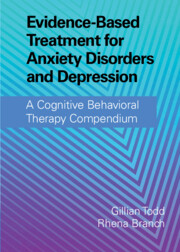 Evidence-Based Treatment for Anxiety Disorders and Depression
Evidence-Based Treatment for Anxiety Disorders and Depression Book contents
- Evidence-Based Treatment for Anxiety Disorders and Depression
- Evidence-Based Treatment for Anxiety Disorders and Depression
- Copyright page
- Contents
- Figures
- Tables
- Contributors
- 1 Introduction
- 2 The History and Philosophical Underpinnings of CBT:
- Part One Cognitive Behavioral Therapy for Anxiety Disorders
- Part Two Cognitive Behavioral Therapy for Posttraumatic Stress Disorder
- Part Three Cognitive Behavioral Therapy for Obsessive-Compulsive Disorder and Associated Disorders
- 11 Obsessive-Compulsive Disorder:
- 12 CBT for OCD:
- 13 Obsessive Compulsive Disorder:
- 14 Other Specified and Unspecified Obsessive-Compulsive and Related Disorders
- 15 A Cognitive Behavioral Approach to Body Dysmorphic Disorder:
- 16 Comprehensive Behavioral Treatment for Trichotillomania (Hair Pulling Disorder) and Excoriation (Skin Picking) Disorder
- 17 Cognitive Behavioral Therapy for Hoarding Disorder
- Part Four Cognitive Behavioral Therapy for Depression
- Part Five Complexity and Comorbidity in Anxiety Disorders and Depression:
- Part Six Specialist Applications of Cognitive Behavioral Therapy for Anxiety Disorders and Depression
- Part Seven Future Developments
- Appendices
- Index
- References
17 - Cognitive Behavioral Therapy for Hoarding Disorder
from Part Three - Cognitive Behavioral Therapy for Obsessive-Compulsive Disorder and Associated Disorders
Published online by Cambridge University Press: 06 January 2022
- Evidence-Based Treatment for Anxiety Disorders and Depression
- Evidence-Based Treatment for Anxiety Disorders and Depression
- Copyright page
- Contents
- Figures
- Tables
- Contributors
- 1 Introduction
- 2 The History and Philosophical Underpinnings of CBT:
- Part One Cognitive Behavioral Therapy for Anxiety Disorders
- Part Two Cognitive Behavioral Therapy for Posttraumatic Stress Disorder
- Part Three Cognitive Behavioral Therapy for Obsessive-Compulsive Disorder and Associated Disorders
- 11 Obsessive-Compulsive Disorder:
- 12 CBT for OCD:
- 13 Obsessive Compulsive Disorder:
- 14 Other Specified and Unspecified Obsessive-Compulsive and Related Disorders
- 15 A Cognitive Behavioral Approach to Body Dysmorphic Disorder:
- 16 Comprehensive Behavioral Treatment for Trichotillomania (Hair Pulling Disorder) and Excoriation (Skin Picking) Disorder
- 17 Cognitive Behavioral Therapy for Hoarding Disorder
- Part Four Cognitive Behavioral Therapy for Depression
- Part Five Complexity and Comorbidity in Anxiety Disorders and Depression:
- Part Six Specialist Applications of Cognitive Behavioral Therapy for Anxiety Disorders and Depression
- Part Seven Future Developments
- Appendices
- Index
- References
Summary
Patients with hoarding disorder (HD) experience difficulties discarding that result in excess clutter in the home. HD causes distress and impairment for patients and family members and represents a significant public health burden, highlighting a need for treatment research. In this chapter, we provide an overview of cognitive behavioral therapy (CBT) for hoarding, a promising avenue to treat core HD features in a collaborative and time-limited manner. We begin by discussing etiological factors for HD, including familial features, information-processing deficits, and core beliefs about the self and possessions. Next, we describe HD assessment, including standardized measures and case conceptualization considerations. After discussing the research evidence for individual and group CBT for HD, we provide an overview of treatment components, including psychoeducation, motivational enhancement, skills training, behavioral exposures, cognitive techniques, and relapse prevention. Barriers to treatment are also considered. We end with a case vignette illustrating the successful application of CBT for HD in an individual outpatient setting.
Keywords
- Type
- Chapter
- Information
- Evidence-Based Treatment for Anxiety Disorders and DepressionA Cognitive Behavioral Therapy Compendium, pp. 341 - 364Publisher: Cambridge University PressPrint publication year: 2022


